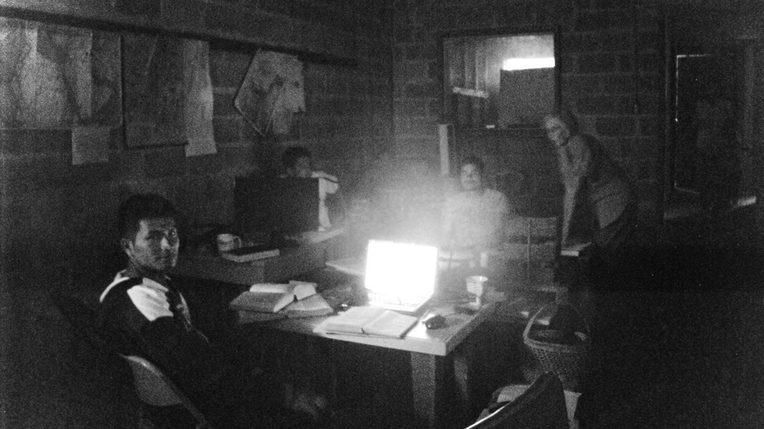Digitality, Analogicity, and Computation
From the Series: Digital Ontology
From the Series: Digital Ontology

When we discuss the digital, we usually mean computers and new technologies of information and communication. We wonder if they can transform society and what it means to be human. We emphasize or contest the novelty of these technologies. We describe how they affect and are affected by traditional domains of anthropological inquiry. We propose that they take us beyond humanity or beneath it, increase or diminish our freedom, are material or virtual. We try to uncover the anthropologies at work in designing their interfaces. As we do so, we lose sight of the digital as such. Here, I argue that we need more robust definitions of digitality to resist capture by discourses of hype. I propose a more technical definition of the digital and a framework for examining digitality itself.

I propose to disentangle the digital from computation and to place it alongside the analog. Digital and analog refer to the forms of a signal, which an electronic machine can compute. Digital signals are signals made up of discrete entities (e.g., numbers; letters), while analog signals are continuous (e.g., a radio wave). Most of the objects that we have studied under the guise of the digital in fact combine both analog and digital. Many convert one into the other. For instance, a digital camera converts (analogic) light into (digital) information, which a computer then converts back into an image. I propose to shift our attention from new technologies of information and communication to the production of discrete and continuous information. When we do so we can focus on digitality and its relevance for anthropological theory, rather than only on the ways that humans use and are affected by it.
But how can anthropologists study signals? Is digitality not inhuman? Must we not convert it into analog signals for humans to access it? A number of ethnographic studies of digitality as such, unencumbered by electronic computation, already exist. For instance, Jadran Mimica (1988) has described the Yagwoia counting system as a constitutive part of their lifeworld. Helen Verran’s (2001) approach to Nigerian counting shows the agency of numbers in sensemaking. Gary Urton (1997) examines the Andean Quechua ontology of numbers in relation to kinship, weaving, and literacy. These three examples show how numbers structure and shape worlds that humans also inhabit. They describe how numbers emerge as discrete entities from the continuum of social life. That is, they describe ontologies of the digital and processes of digitization.
We can understand digitization as the production of discrete entities out of a continuum. Analogization describes the opposite process, whereby a continuum gets produced out of discrete entities. These constitute the fundamental characteristics of what Philippe Descola (2005, 324–25) calls totemic and analogic ontologies. In analogic ontologies, discontinuity forms the basis for the recomposition of continuity. In totemic analogies, a continuum of interiorities and physicalities is cut through to produce complementary segments. Totemism and analogism become machines that produce the digital and the analog. Descola’s work has, at times, been read as representational or cartographic. Instead I read it as providing blueprints for digital and analog machines. Beyond ethnographies of numbers, Descola’s work opens up a vast comparative framework for the digital. The opposition between analogism and digitality itself constitutes an example of digitalization.
We can also recognize digitality as an epistemic device (Galloway 2014). Anthropology, at least since the 1980s, has been much better at analogizing than at digitalizing. The poststructuralist moment consisted in analogizing the human world that structuralism had digitalized. Forms of individuality were placed within a process of individuation. Each informant became a life-story. Each binary opposition became a spectrum of possibilities or a hybrid. Each social structure, a moment in the relation between societies. In other words, the continuum became the fundamental ontology of anthropology (see Zalamea 2012). We called upon thinkers of analogism, such as Charles Peirce (Kohn 2013) and Gilles Deleuze (Viveiros de Castro 2009) to convert structuralist digitality.
Are analog ontologies of the digital the only possibility? How might a new anthropology digitalize poststructuralist analog pictures of the world? This process would begin by distinguishing between digital and analog anthropologies and by reconsidering structuralism. We must recover structuralism as the most accomplished attempt at a digital anthropology. Instead of opposing it to the analog as the pre to our present post, we must allow for conversions from one to the other. The work of Alain Badiou (1988, 2006) is here exemplary, in its combination of a discrete ontology with a continuous phenomenology.
By taking the digital to the letter, I have outlined a different genealogy for digital anthropology. It favors ethnographies of numbers or totemic ontologies over studies of sociotechnical change. I also suggest that most turns in the discipline since the 1980s have enacted a triumph of the analogic over the digital. A real digital turn would involve more than an anthropology-with-computers. It would need to involve a reevaluation of anthropological theory from 1949 onward.
Badiou, Alain. 1988. L’être et l’événement. Paris: Éditions du Seuil.
_____. 2006. Logiques des mondes: L’être et l’événement, 2. Paris: Éditions du Seuil.
Descola, Philippe. 2005. Par-delà nature et culture. Paris: Gallimard.
Galloway, Alexander. 2014. Laruelle: Against the Digital. Minneapolis: University of Minnesota Press.
Kohn, Eduardo. 2013. How Forests Think: Toward an Anthropology Beyond the Human. Berkeley: University of California Press.
Mimica, Jadran. 1988. Intimations of Infinity: The Mythopoeia of the Iqwaye Counting System and Number. Oxford: Berg.
Urton, Gary. 1997. The Social Life of Numbers: A Quechua Ontology of Numbers and Philosophy of Arithmetic. Austin: University of Texas Press.
Verran, Helen. 2001. Science and an African Logic. Chicago: University of Chicago Press.
Viveiros de Castro, Eduardo. 2009. Métaphysiques cannibales: Lignes d’anthropologie post-structurale. Paris: Presses Universitaires de France.
Zalamea, Fernando. 2012. Peirce's Logic of Continuity: A Conceptual and Mathematical Approach. Boston: Docent.